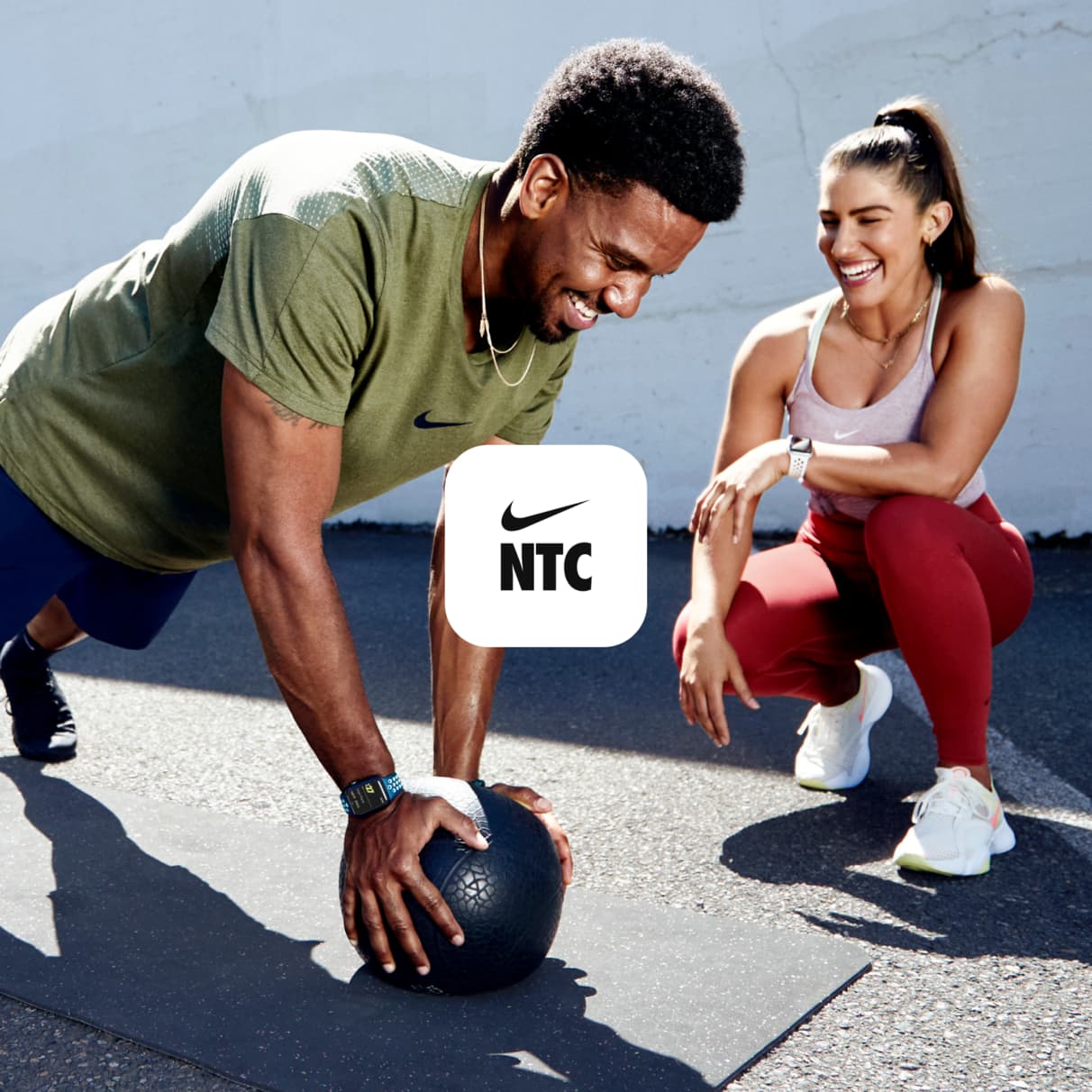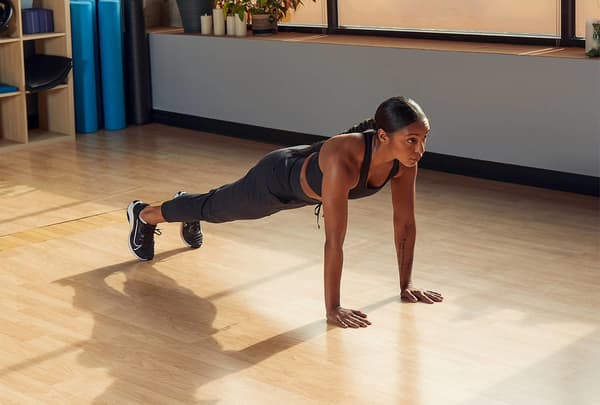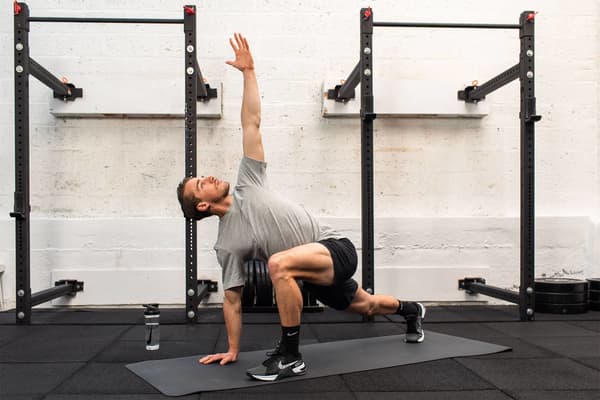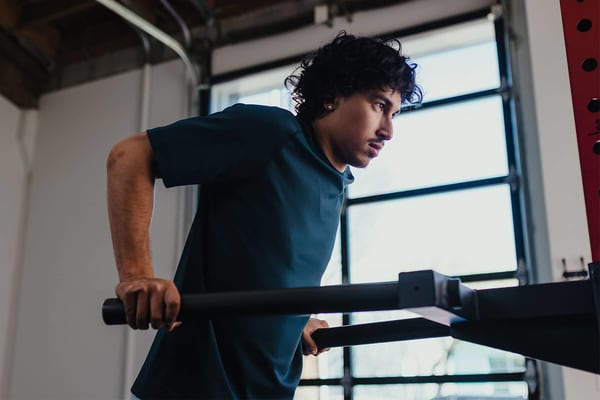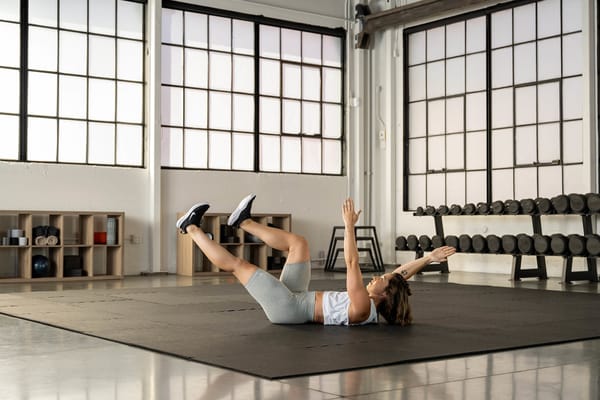7 von Trainer:innen empfohlene Plank-Variationen
Sport und Bewegung
Diese besonderen Plank-Varianten werden von zertifizierten Personal Trainer:innen empfohlen und sollen deinen Core sowie deinen Ober- und Unterkörper gleichzeitig stärken.
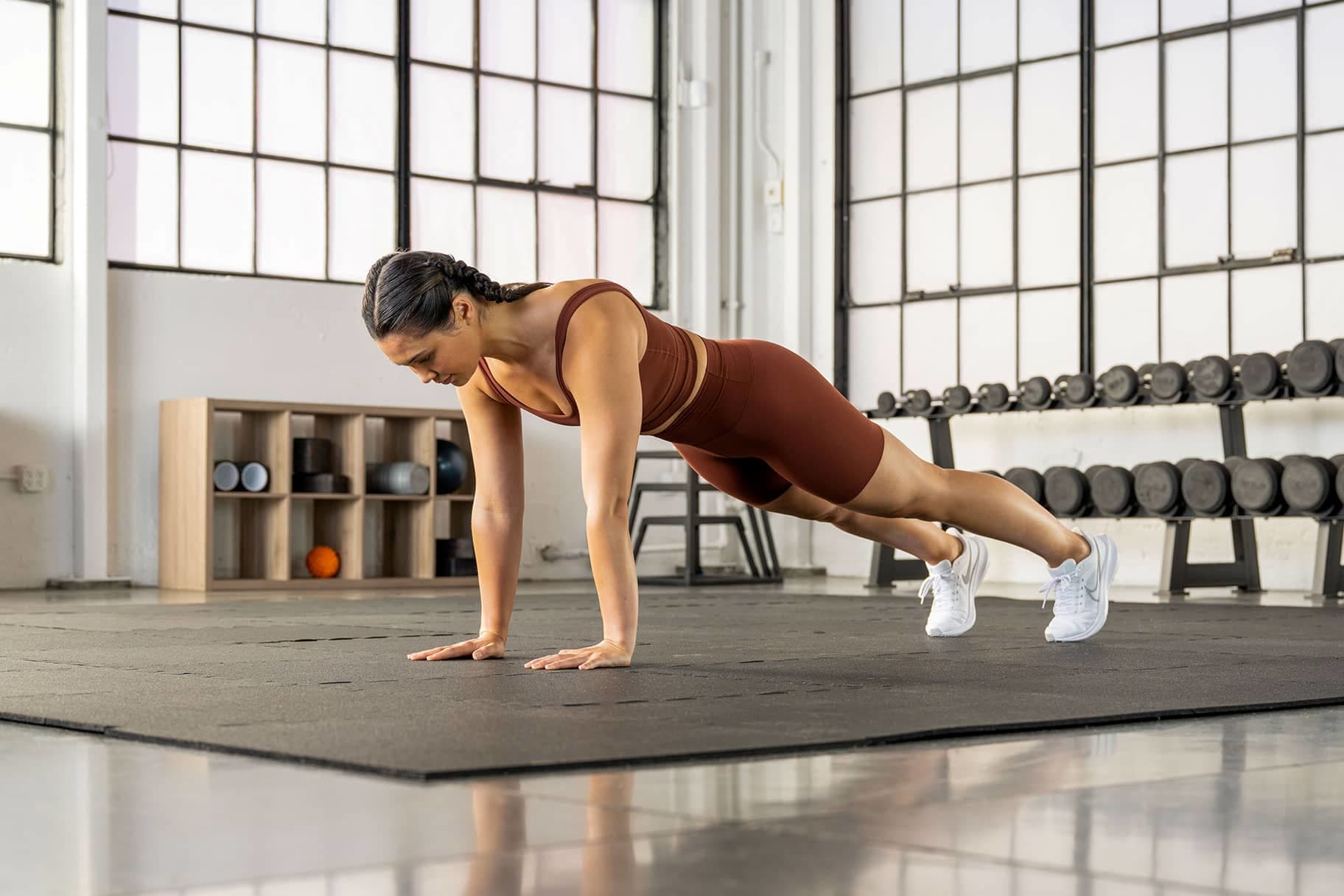
So sehen optimale Plank-Übungen aus
Pierre sagt, du kannst dir dazu ein Bild mit einer Schnur vorstellen, die zwischen deinen Schulterblättern mit der Wirbelsäule verbunden ist und an der ständig gezogen wird, sodass die obere Wirbelsäule immer in der richtigen Position ist (am besten stellst du dir vor, die Wirbelsäule zu heben). Im Fußbereich sollten die Fersen mit der Fußsohle ausgerichtet sein, damit die Quadrizeps-Muskeln stärker beansprucht werden, sagt sie. Um diese Position zu erreichen, kannst du den Fuß so weit strecken, bis deine Fersen die Rückwand berühren.
Alemar empfiehlt auch, dass du dich bei der traditionellen Plank-Übung auf das Halten einer Beckenkippung konzentrierst und vermeidest, dass die Hüfte abgesenkt wird oder sich die Wirbelsäule krümmt.
Und vergiss dabei nicht das Atmen. "Achte darauf, nicht den Atem anzuhalten, und spann deine Bauchmuskeln an, während du hinter dieser Anspannung atmest", erklärt er. Dies kann sich beim ersten Mal etwas seltsam anfühlen, aber laut Alemar kannst du die Plank-Übung so länger halten.
Bei Trainer:innen beliebte Plank-Variationen
Möchtest du Planks in dein Trainingsprogramm aufnehmen? Alemar und Pierre stellen ihre bevorzugten Plank-Übungen vor.
1.Plank on Knees
If you’re new to planking and can’t hold a traditional plank for 30 seconds, performing planks on your knees is a great place to start, Alemar said. Starting with this variation will allow you to get acclimated to the movement and learn and reinforce proper movement patterns.
- Start by lying on your stomach with your hands slightly outside your chest.
- With control, push through the palms of your hands as you extend your arms. Be sure to engage your core and maintain a neutral spine.
- If you want, lift your feet off the ground to balance on your knees.
- Hold for 15 seconds. If you’re more advanced, hold for 30 seconds.

2.High Plank
This is one of the most popular plank variations and rightfully so. This variation places a greater emphasis on the pectoral and serratus muscles, Alemar said. When performing high planks, make sure your wrists are in line with your shoulders or slightly behind to further engage the serratus muscle.
- Start by lying on your stomach with your hands slightly outside your chest and your toes tucked.
- With control, push through your hands and feet, lifting your entire body off the ground simultaneously. Be sure to engage your core and glutes. Your head, spine and legs should be in a neutral position. Your shoulders, elbows and wrists should also be aligned.
- Be sure not to round or arch your back and to keep the palms of your hands flat on the ground.
- Hold for 15 seconds. If you’re more advanced, hold for 30 seconds.

3.Side Plank
This plank variation is excellent for developing stability in your spine while also challenging the hips and obliques, Alemar said.
- Start lying on your side with your body in a straight line from head to toe.
- Depending on your ability, you can either place your forearm on the ground or your hand. If you’re placing your forearm on the ground, make sure that your elbow is in line with your shoulder. If your hand is on the ground, make sure your hand is underneath your shoulder.
- With control, push through your forearm and hand as you simultaneously lift your hips off the ground.
- Your body should be in a straight line from head to toe and your full hand or forearm should be on the ground. Be sure to engage your core and squeeze your glutes.
- Hold for 15 seconds on each side. If you’re more advanced, hold for 30 seconds on each side.

4.Reverse Plank
If you’re bored with your current ab routine, take it to the next level with reverse planks, which not only target your core muscles, but also the glutes, hamstrings and lower back.
- Start seated with your legs bent and your hands behind your glutes with your fingers pointing towards your feet.
- From here, extend your legs, keeping your heels on the ground.
- With control, push through your hands as you lift your glutes and legs off the ground.
- Keep your chin in a neutral position and squeeze through your glutes to maintain proper form.
- Hold for 15 seconds. If you’re more advanced, hold for 30 seconds.

5.Plank Kick Through
Ready to challenge yourself? Try adding plank kick throughs to your routine. This movement is dynamic, and will challenge your core, arm, oblique and hip strength while generating heat throughout your body, Pierre said.
- Start in a traditional high plank position.
- With control, begin to shift your weight to the right side of your body as you rotate to the right, bending your left leg at the knee and lifting your left hand off the ground while simultaneously extending the right leg across the body.
- With control, return to the starting position, then repeat the same movement on the opposite side.
- This counts as one rep. Perform 10 reps.

6.Superman Plank
This plank variation is excellent for all levels, Pierre said. It will challenge your stability in addition to your core and can always be regressed if necessary.
- Start in a traditional high plank position.
- With control, simultaneously raise your left hand off the ground and extend it out in front of you as you lift your right toes off the ground. The leg being lifted does not need to come more than a few inches off the ground. Be sure not to shift your weight to the left or right side of your body.
- With control, place the left arm and right leg back down, returning to the starting position.
- Repeat on the opposite side.
- This counts as one rep. Perform 10 reps.

7.Plank to Squat
If you like more dynamic, diverse movements, consider adding this variation into your routine. It hits all the muscles a traditional plank would in addition to stretching and opening the hips and activating the glute muscles.
- Start in a traditional high plank position.
- With control, either walk or gently jump your feet to the outside of your hands coming into a squat. You can lift your hands off the ground to make the movement more dynamic.
- With control, gently jump or walk your feet back to a high plank position.
- This counts as one rep. Perform 10 reps.

So nimmst du Plank-Übungen in dein Trainingsprogramm auf
Möchtest du ein paar neue Core-Moves in dein Programm aufnehmen? Laut Alemar kannst du am besten Plank-Übungen in dein Übungsprogramm aufnehmen, indem du zwei Varianten auswählst (im Idealfall anfängerfreundlich, wenn du keine Erfahrung mit Planks hast). Dies können zum Beispiel eine Forearm Plank und eine Side Plank sein. Von beiden kannst du jeweils drei Wiederholungen auf Zeit machen. Diese Zeit kann unterschiedlich sein, zum Beispiel 10 oder 30 Sekunden. Such dir aus, was du dir zutraust, aber dies darf nicht auf Kosten deiner Haltung gehen.
Wenn es schwierig ist, eine Plank 30 Sekunden lang zu halten, empfiehlt Alemar, die Bewegung zu deinen Knien anzupassen oder, falls möglich, sie über einen kurzen Zeitraum zu halten. Wenn du eine Plank 30 Sekunden lang halten und drei Wiederholungen machen kannst, solltest du laut Alemar die Dauer, die du die Pose hältst, in Schritten von 10 Sekunden verlängern, bis du sie eine Minute lang halten kannst. Ab dann empfiehlt er, allmählich mit schwierigeren Varianten weiterzumachen.
Das Schöne am Gestalten von Trainingsprogrammen ist, dass es immer sehr viele Möglichkeiten gibt, ein Ziel zu erreichen. Pierre ist überzeugt von Plank-Übungen während des Warm-ups eines Workout, um den Core zu aktivieren, den Wärmefluss im Körper in Gang zu bringen und den Körper generell aufzuwärmen.
Alemar schlägt vor, Plank-Übungen zwischen anderen kombinierten Bewegungen, bei denen gleichzeitig mehrere Muskelgruppen beansprucht werden, als dritte oder vierte Übung zu machen. Du könntest beispielsweise eine Reihe von Squats, dann Rudern und dann eine Unterarm-Plank-Übung machen.
Wichtig ist dabei, dass du, wenn du deinen Core effektiv trainieren möchtest, auch andere Arten von Übungen zur Kräftigung des Core machen solltest, bei denen die anderen Muskeln in deinem Core beansprucht werden. Außerdem solltest du auch Bewegungen für Dynamik, Rotation und Anti-Rotation in dein Programm aufnehmen.
Wie bei anderen Übungen ist auch hier wichtig, die Muskeln nicht zu überfordern, und Alemar empfiehlt zwei- oder dreimal pro Woche spezielle Bewegungen für den Core.
Bei allen Plank-Varianten solltest du aber nie deine Haltung vernachlässigen. Deine Schultern, Handgelenke und Ellbogen sollten eine Linie bilden, wobei deine Wirbelsäule gerade bleibt (Po nach unten).
Text von Tamara Pridgett
